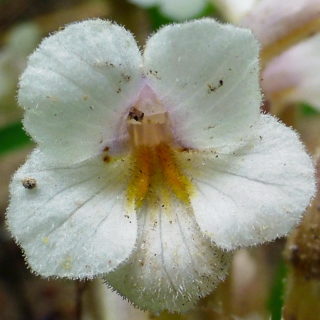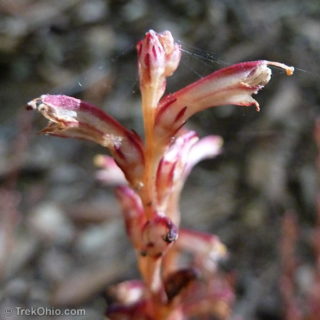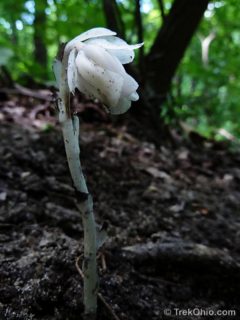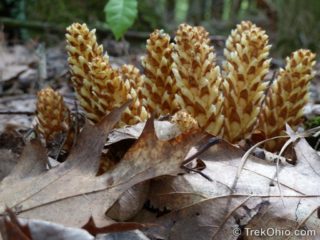 One-flowered broomrape (Orobanche uniflora) is also known as oneflowered broomrape, naked broomrape, cancer root, one-flowered cancer root, pipes, ghost pipes, squawdrops, and squirrel's grandfather. It is the fourth plant that we've dealt with here that has no chlorophyll. Without chlorophyll the plant is unable to nourish itself through photosynthesis, so it lives its life as a parasite, siphoning off its nourishment from other plants. Unlike the previous parasitic plants that we've discussed, Read more ➜
One-flowered broomrape (Orobanche uniflora) is also known as oneflowered broomrape, naked broomrape, cancer root, one-flowered cancer root, pipes, ghost pipes, squawdrops, and squirrel's grandfather. It is the fourth plant that we've dealt with here that has no chlorophyll. Without chlorophyll the plant is unable to nourish itself through photosynthesis, so it lives its life as a parasite, siphoning off its nourishment from other plants. Unlike the previous parasitic plants that we've discussed, Read more ➜ One-flowered broomrape: a plant without chlorophyll
 One-flowered broomrape (Orobanche uniflora) is also known as oneflowered broomrape, naked broomrape, cancer root, one-flowered cancer root, pipes, ghost pipes, squawdrops, and squirrel's grandfather. It is the fourth plant that we've dealt with here that has no chlorophyll. Without chlorophyll the plant is unable to nourish itself through photosynthesis, so it lives its life as a parasite, siphoning off its nourishment from other plants. Unlike the previous parasitic plants that we've discussed, Read more ➜
One-flowered broomrape (Orobanche uniflora) is also known as oneflowered broomrape, naked broomrape, cancer root, one-flowered cancer root, pipes, ghost pipes, squawdrops, and squirrel's grandfather. It is the fourth plant that we've dealt with here that has no chlorophyll. Without chlorophyll the plant is unable to nourish itself through photosynthesis, so it lives its life as a parasite, siphoning off its nourishment from other plants. Unlike the previous parasitic plants that we've discussed, Read more ➜  Most plants are green because of their chlorophyll which both tints their leaves and allows them to manufacture their own nutrition. However there are plants without chlorophyll; these plants aren't green, nor do they have leaves. So they turn to other living things to meet their nutritional needs. There are two categories of plants without chlorophyll depending on whether the plant directly gets its nutrition from another plant, or indirectly via a fungus which in turn gets its food from a plant.
Most plants are green because of their chlorophyll which both tints their leaves and allows them to manufacture their own nutrition. However there are plants without chlorophyll; these plants aren't green, nor do they have leaves. So they turn to other living things to meet their nutritional needs. There are two categories of plants without chlorophyll depending on whether the plant directly gets its nutrition from another plant, or indirectly via a fungus which in turn gets its food from a plant.  The white flower above is known by several names: Indian pipe, Ghost plant and Corpse plant. Like squawroot, Indian pipe can't meet its own nutritional needs since it has no chlorophyll. It leads a parasitic life just as squawroot does.
While squawroot gets its nutrition by directly tapping into the roots of oak trees, Indian pipe gets its nutrition more indirectly. It's host organism is a fungus, a member of the Russulaceae family. This fungus gets its nutrition from tree roots. However
The white flower above is known by several names: Indian pipe, Ghost plant and Corpse plant. Like squawroot, Indian pipe can't meet its own nutritional needs since it has no chlorophyll. It leads a parasitic life just as squawroot does.
While squawroot gets its nutrition by directly tapping into the roots of oak trees, Indian pipe gets its nutrition more indirectly. It's host organism is a fungus, a member of the Russulaceae family. This fungus gets its nutrition from tree roots. However  When other seeds germinate, the seedlings struggle to emerge into the sunlight, so they can photosynthesise and make their own nutrition. When a squawroot seed germinates, it squirms farther underground in search of its nourishment. It "feels around" in the dark until it finds the root of an oak or beech tree and latches on for dear life. For the rest of its life it will feed parasitically off these tree roots. The oak roots develop little, knobby protuberances where the squawroot has latched on,
When other seeds germinate, the seedlings struggle to emerge into the sunlight, so they can photosynthesise and make their own nutrition. When a squawroot seed germinates, it squirms farther underground in search of its nourishment. It "feels around" in the dark until it finds the root of an oak or beech tree and latches on for dear life. For the rest of its life it will feed parasitically off these tree roots. The oak roots develop little, knobby protuberances where the squawroot has latched on,